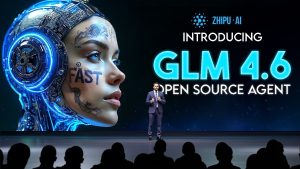Google Unveils AI Designed to Improve Internet Functionality and Performance.

Google DeepMind Unveils Code Mender: Autonomous AI for Code Security
Google DeepMind has made significant strides in artificial intelligence with the introduction of Code Mender, an AI that autonomously identifies and resolves security vulnerabilities in large-scale open-source projects. This groundbreaking technology is designed not only to enhance cybersecurity but also to revolutionize how we perceive coding interventions.
What is Code Mender?
Code Mender is marketed as an AI code developer that specializes in open-source security. In just six months, it validated and upstreamed 72 security fixes across various projects, including those encompassing millions of lines of code. Unlike traditional automated tools that merely scan for vulnerabilities, Code Mender demonstrates a comprehensive understanding of code structure and logic. It can identify the root cause of issues, generate patches, and validate them automatically, significantly reducing the time lag between detection and resolution.
Technical Insights
Code Mender operates using Google’s Gemini Deepthink model. This model is specifically fine-tuned for code reasoning, enabling the AI to debug, patch, and even rewrite substantial code sections while ensuring consistency in style and functionality. With this capability, Code Mender not only repairs security flaws but also checks for regressions to prevent new issues from emerging. Once a patch is created, it is sent to human developers for review before being integrated into the codebase.
One notable instance of Code Mender’s capacity was its detection of a heap buffer overflow resulting from incorrect XML stack management. This kind of vulnerability can easily elude even seasoned developers. Additionally, it successfully mitigated a significant flaw in the libwebp image compression library, which had previously been exploited in a zero-day attack against Apple’s iOS. Code Mender applied safety annotations, guiding the compiler to enforce bounds checks and thereby averting potential exploits.
Innovative Techniques
Under the hood, Code Mender employs a suite of advanced program analysis tools, including static analysis, dynamic analysis, fuzzing, differential testing, and SMT solvers. This multifaceted approach enables the AI to effectively analyze data flow through code and pinpoint vulnerabilities. Moreover, it utilizes a multi-agent system where specialized sub-agents tackle distinct debugging tasks. For example, one sub-agent is dedicated to critiquing code changes, ensuring no new regressions are introduced. If issues arise, the AI triggers self-correction steps automatically, thus maintaining the integrity of the code.
Proactive Code Improvements
Beyond merely reacting to bugs, Code Mender takes the initiative to rewrite code to enhance safety proactively. It has been given access to existing codebases and tasked with improving their security by switching to safer data structures or implementing compiler-level safeguards. This forward-thinking approach not only resolves current issues but preemptively secures the code against future vulnerabilities.
The Role of Neo in AI Development
Navigating the complexities of building AI systems typically involves extensive trial and error processes. Here, Neo comes into play, functioning as a fully autonomous machine-learning agent that streamlines the entire workflow. Neo handles everything from raw data processing and feature engineering to training and deployment, making the development cycle far more efficient. It has proven its capabilities by excelling in various machine-learning competitions, showcasing a 34% success rate across multiple runs.
Code Mender’s Real-World Applications
Code Mender’s operational success illustrates its potential in various contexts. DeepMind is already exploring further applications, such as integrating AI for ransomware detection within Google Workspace. These advancements suggest that AI could assume an even broader role in cybersecurity, moving beyond coding assistance to become integral to maintaining the open-source ecosystem.
Gemini 2.5: A New Chapter in AI Efficiency
Alongside Code Mender, Google has also introduced Gemini 2.5 Computer Use, a specialized model capable of operating software in a manner akin to human interaction. This model can navigate web interfaces autonomously, completing tasks such as filling out forms, clicking through menus, and performing drag-and-drop operations.
For example, when prompted, Gemini 2.5 successfully navigated to a pet care signup form, gathered information about pets, updated a CRM system, and scheduled a future appointment—demonstrating its practical application in real-world scenarios.
How Gemini 2.5 Works
Operating in a loop, Gemini 2.5 begins each task by analyzing a screenshot of the user interface alongside the user’s request. From there, it determines the necessary actions—such as clicking or typing—executes them, and reevaluates the interface until the goal is met or an error occurs. The focus is primarily on web interfaces, but promising developments for mobile UI control are underway.
Benchmark assessments position Gemini 2.5 Computer Use at the forefront of AI technology. It has shown superior performance over competing models in tasks requiring online navigation, achieving over 70% accuracy while maintaining a latency of around 225 seconds per task.
Safety Considerations
While the capabilities of Code Mender and Gemini 2.5 are revolutionary, they do raise concerns regarding safety and oversight. DeepMind has proactively integrated safeguards into both models. A per-step safety service evaluates each proposed action, ensuring that the AI does not undertake risky maneuvers such as bypassing security protocols or compromising sensitive information.
Developers can also set customized safety measures to require human input for high-stakes actions. Transparency is crucial, and DeepMind has published a detailed system card explaining how it addresses potential risks, including misuse and unexpected model behavior.
Conclusion
As AI technology continues to evolve, Code Mender and Gemini 2.5 signify a new era where AI not only assists developers but actively participates in maintaining and enhancing code security. The future landscape of software development may soon see AI working alongside human engineers, offering unparalleled efficiency and security in code management.
Stay tuned for more updates as this exciting technology unfolds!
#Google #Dropped #Fixes #Internet
Thanks for reaching. Please let us know your thoughts and ideas in the comment section.
Source link






👉 Request Early Access for NEO: https://tinyurl.com/heyneo
❤❤❤ #NicetoobeNice
third!
Four for Thor!!!!
This is supercool and I learn all I can about ai, but does anyone else have any qualms with invasive, snooping, personal info hungry Google making such advanced ai? And does anyone feel ok while using their ai? I prefer chat so far. Thoughts??
Great!!! I can see my job vanishing
❤K👀7❤
looove you! hihi i see the insüirations bebos
Lol went from an American to an English accent in the last 5 seconds. On purpose?